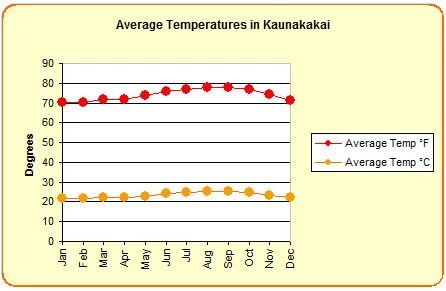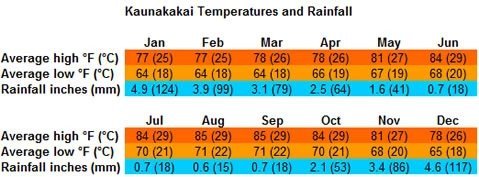Molokai Weather
Molokai weather features sunny, dry conditions along the south and west shores, while the north shore sees more rain due to trade winds and sea cliffs. Average ocean temperatures range from 75°F in winter to 82°F in late summer. Visitors usually stay on the drier south side, where most accommodations are located. Occasional vog from the Big Island may affect air clarity.
Just like on the other main Hawaiian islands, the weather on Molokai's south shore is usually drier and sunnier than on the island's north shore. That's because the predominant trade winds are blowing from the northeast about 90% of the time in the summer months (May to September) and about 50% of the time in the winter months (October to April). As moisture-laden clouds approach Molokai from the northeast, they get stuck on the island's tall sea cliffs, where the moisture comes down as rain.
The weather on Molokai's north shore is therefore usually a lot wetter than on the south shore. But since Molokai's north shore is largely undeveloped, you will probably stay somewhere on the island's south or west shore where most of the visitor accommodations are located. The island's main town, Kaunakakai, is located on the south shore. Molokai's average ocean temperature is around 75°F (24°C) in February and 82°F (28°C) in September.


Volcanic smog (vog) on Molokai
Vog (volcanic smog) is much more common on Hawaii's Big Island than on Molokai since the Big Island is the only Hawaiian island that still has active volcanoes. Occasionally when the winds are blowing from the south (known as Kona winds), the vog from the Big Island's volcanoes affects the air quality of the other Hawaiian islands, including Molokai.
On those days you will notice a haze in the air, especially when looking into the distance. While most people can tolerate vog and won't notice any difference in how they are feeling, for those with asthma or other breathing problems vog is much more of an issue and it is best be avoided by staying indoors.
Frequently Asked Questions about Molokai Weather
Is Molokai's weather always sunny?
Molokai's south and west shores are typically sunny and dry. The north shore is wetter due to trade wind patterns and high sea cliffs that trap clouds and rain.
Which part of Molokai gets the most rain?
The north shore receives the most rainfall because of orographic lifting from trade winds hitting the cliffs. However, it's mostly undeveloped and not where visitors typically stay.
What's the ocean temperature on Molokai?
The ocean temperature averages around 75°F (24°C) in February and 82°F (28°C) in September.
Does vog affect Molokai?
Molokai occasionally experiences vog (volcanic smog) from the Big Island when Kona winds blow. It may cause haze and slight breathing discomfort for sensitive individuals.








